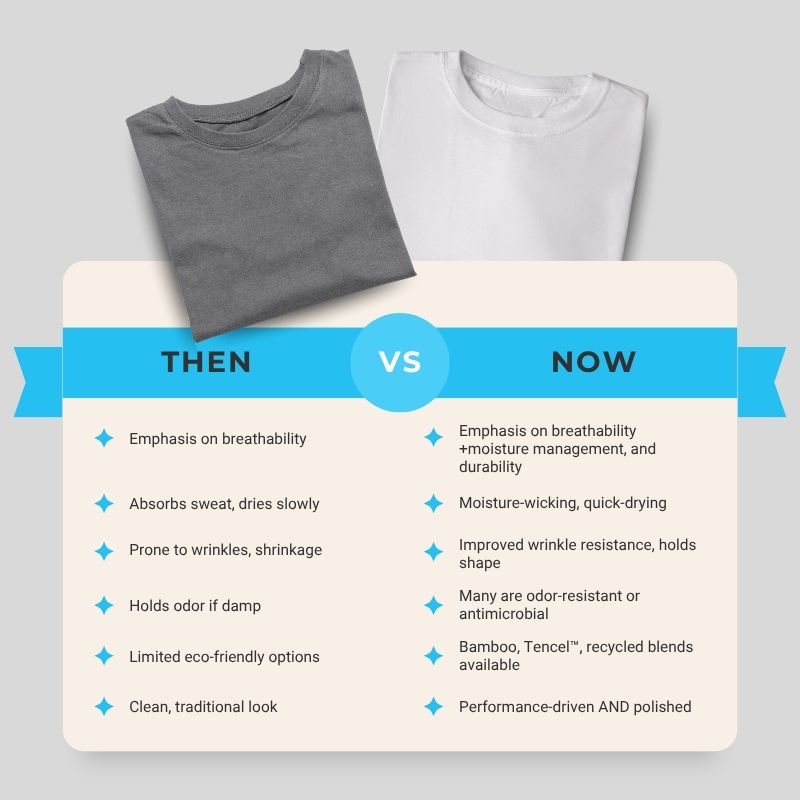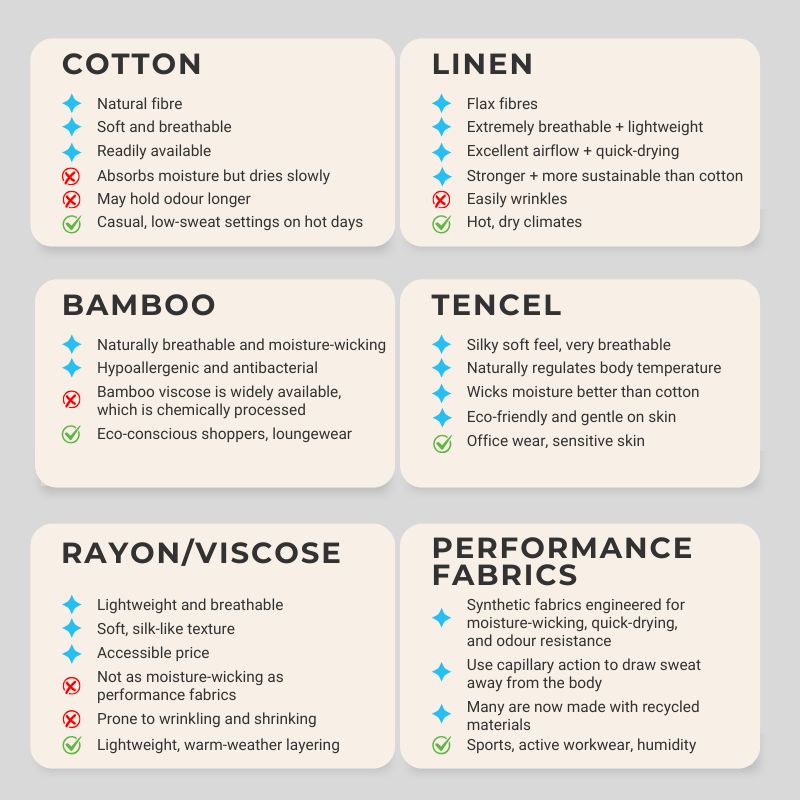Welcome to our new website!
When it is cold, staying comfortable is as simple as adding another layer. But in the heat of summer, there is only so much you can adjust. Unlike colder months where layering offers flexibility, warm weather puts greater demands on the garments themselves to keep wearers cool, dry, and comfortable.
For businesses, this presents a unique challenge. Whether your team is working outdoors, engaging with customers, or constantly on the move, heat and humidity affect more than just comfort—they can impact focus, energy levels, and overall morale.
That is why choosing the right fabric is essential. From understanding which materials perform best in certain conditions to considering additional factors like moisture management and airflow, making informed apparel choices can go a long way in helping your team stay cool and confident on the job.
Originally, cotton was the go-to fabric for staying cool. It was widely known for its breathability and offered a clean, professional appearance that suited many workplace settings. But over time, changing job demands, rising temperatures, and advancements in textile technology have shifted what businesses need—and expect—from their apparel.
Today, it is not just about breathability. Businesses are looking for fabrics that offer moisture-wicking performance, faster drying times, odour resistance, and better shape retention—especially for employees working outdoors or on the move throughout the day.
This shift has led to the rise of materials like Tencel™, bamboo viscose, and technical poly blends, which are specifically engineered to perform in real-world conditions without compromising on appearance.
What was once about staying cool has evolved into a focus on all-day comfort, durability, and functionality—a clear reflection of how modern workwear must keep pace with modern demands.

Aside from keeping cool, protection from harmful UV rays has become an equally important consideration—especially for those spending extended periods outdoors. UPF-rated garments began receiving standardized testing and certification in the late 1990s to early 2000s, helping ensure that sun protection claims are accurate and reliable.
UPF-rated fabrics are designed to combine breathability and cooling comfort with built-in sun protection, helping to reduce the risk of sunburn and long-term skin damage. For outdoor roles in industries like construction, landscaping, or logistics, UPF garments offer a practical way to support both safety and comfort on the job.
For a deeper dive into UPF clothing and its benefits, check out our dedicated post here.

Choosing the right fabric is not just about climate—it is also about understanding who will be wearing it, where, and how. If your team operates mostly indoors or in climate-controlled spaces, you may not need the most advanced moisture-wicking fabric. On the other hand, roles that involve physical activity or exposure to heat and humidity call for materials that prioritize performance and comfort.
It is also important to consider the level of customization you are planning. At Q Custom Clothing, we offer a range of branding options—like embroidery and other design techniques—that allow you to personalize garments with your logo or artwork.
However, your fabric choice can impact how that customization looks and holds up. For example, lightweight or stretchy fabrics may not be ideal for large, dense embroidery, as the weight can cause the material to pucker or distort.
By understanding both function and finish, you can make fabric selections that meet the needs of your team and represent your brand with polish and durability.

Even with the right material, how a garment is constructed and styled plays a key role in keeping the wearer cool. Factors such as fabric colour, weave, and layering techniques can all contribute to overall comfort in warmer conditions.
Lighter colours—like white, beige, soft greys, and pastels—reflect sunlight and reduce heat absorption, making them ideal for hot environments. The weave of the fabric also affects breathability: looser weaves like poplin, seersucker, or chambray promote better airflow, while tighter weaves tend to retain more heat. Fabric weight is another factor; lighter-weight fabrics typically dry faster and feel cooler against the skin.
While layering is often associated with colder months, it can still play a helpful role in summer. Moisture-wicking base layers help pull sweat away from the skin, improving comfort and dryness. Additionally, choosing relaxed or looser-fitting garments over tighter styles encourages better airflow and circulation.

Keeping your team comfortable in the heat is not just about choosing any "light" fabric—it is about understanding how fabric, construction, environment, and even customization needs all play a role. From classic cotton to modern performance materials, and from thoughtful colour choices to strategic layering, every detail contributes to how well your garments perform in warm and humid conditions.
At Q Custom Clothing, we work with you to find the right balance between function, comfort, and appearance—while offering customization techniques that reflect your brand without compromising garment integrity. Connect with us today to explore your fabric and customization options, and ensure your team looks and feels their best—no matter the temperature. Our team of experts can help you navigate the best solution for your team.














